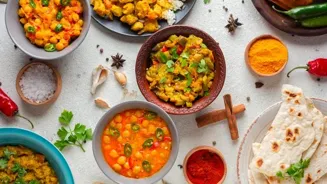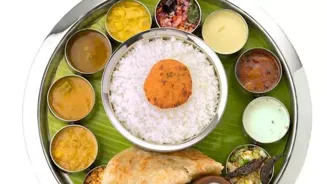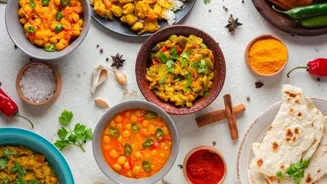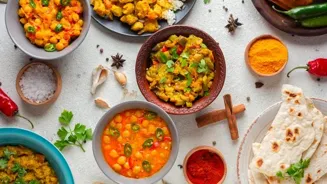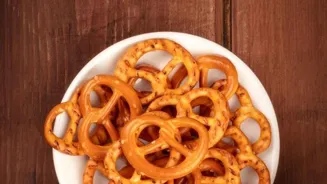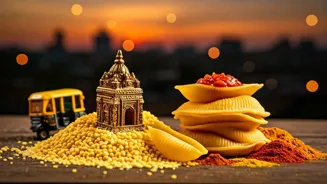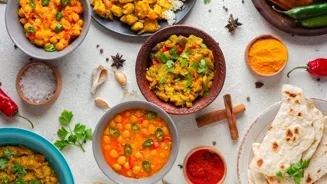Unravel the History of Chaat: India's Iconic Snack Through Time. Delve into its origins and evolution
From the bustling lanes of Chandni Chowk to the swanky malls of Gurgaon, one thing unites Indians across
generations and geographies – their love for chaat.
This savory snack, a symphony of flavors and textures, is more than just food; it's a cultural icon, a nostalgic reminder of childhood, and a vibrant representation of India's diverse culinary landscape. But have you ever stopped to wonder about the origins of this beloved treat?
Let's embark on a delicious journey through time to uncover the fascinating history of chaat.
Origin of chaat in 17th century Mughal kitchens for health
The story of chaat is believed to have begun in the royal kitchens of the Mughal Emperor Shah Jahan in the 17th century.
As the story goes, a severe outbreak of illness plagued the region, and doctors advised the emperor to enforce a diet that included spices and fried foods to strengthen the immune system. It led the royal chefs to experiment with new dishes, and thus, the first iteration of chaat was born.
This original chaat was likely a far cry from the explosion of flavors we experience today, but it laid the foundation for what would become a culinary empire. The primary goal wasn't just taste, but a balanced consumption that incorporated elements designed to combat illness.
The spices, even in their early forms, were carefully selected for their medicinal properties. This early version was less about fun and more about function, reflecting the critical need of the time.
Chaat's journey through India: evolving with regional flavors
The chaat then evolved and travelled. As the Mughal empire expanded, so did the chaat's influence. It spread from Delhi to other parts of North India specially Uttar Pradesh, picking up regional influences and ingredients along the way.
Each region contributed its unique twist, resulting in the diverse range of chaats we see today. For example, in Uttar Pradesh, you might find chaat featuring tamarind chutney and potatoes, while in other regions, yogurt and sev would be prominently featured.
This journey was a process of adaptation, where local ingredients met the fundamental concepts of chaat, birthing countless new possibilities.
This also meant a progressive refinement, in which the dish evolved from a medicinal solution to a culinary delight, reflecting the changing times and tastes.
Lucknow transformed chaat into an elegant culinary art
Lucknow, the city of Nawabs, played a pivotal role in refining the chaat experience. The city became a hub of culinary innovation, and chaatwalas, or chaat vendors, began experimenting with new ingredients and techniques. This gave rise to some of the most iconic chaats.
What separated Lucknow's approach to chaat was a certain sophistication, a refinement that elevated the dish from a simple street snack to an artistic expression.
The way each component was prepared to the precise layering of flavors, Lucknow infused chaat with a touch of elegance, reflecting its history. This also brought professional identity to the cooks who prepared and brought chaat to customers.
Chaat's versatile journey through India's diverse culinary landscape
From the streets of North India, chaat began its journey across the country, adapting to local tastes and available ingredients. In Maharashtra, for instance, bhel puri adapted to the coastal flavours, using puffed rice, sev, and chutneys, creating a light and refreshing snack.
Similarly, in Gujarat, chaat often incorporates a sweet and tangy element, reflecting the region's culinary preference. This pan-Indian adaption is the hallmark of chaat's success.
Its fundamental character permits countless interpretations, permitting it to integrate seamlessly into different culinary traditions. It shows the snack’s capacity to remain both unique and universal.
Chaat's global rise reflects India's rich culinary heritage
Today, chaat is not just a street food; it is a globally recognized Indian snack. From food festivals to Indian restaurants around the world, chaat has made its mark, enticing people with its unique blend of flavors and textures.
It continues to evolve, with new variations emerging every day such as fusion options incorporating Western ingredients.
The enduring allure of chaat lies in its ability to evoke a sense of nostalgia, connection to India's culinary heritage, and the sheer joy of experiencing a food that’s both familiar and surprising. It's a testament to India's rich culinary heritage.
So, the next time you savor a plate of chaat, remember the journey it has taken, from the royal kitchens of Shah Jahan to the global stage, delighting taste buds and uniting people across cultures.
